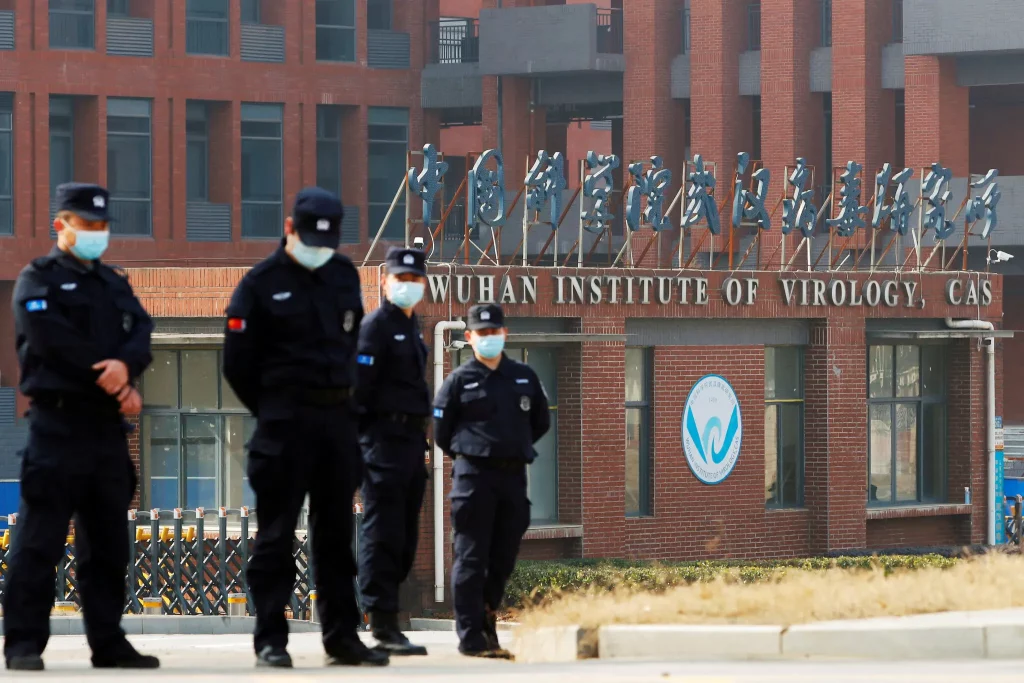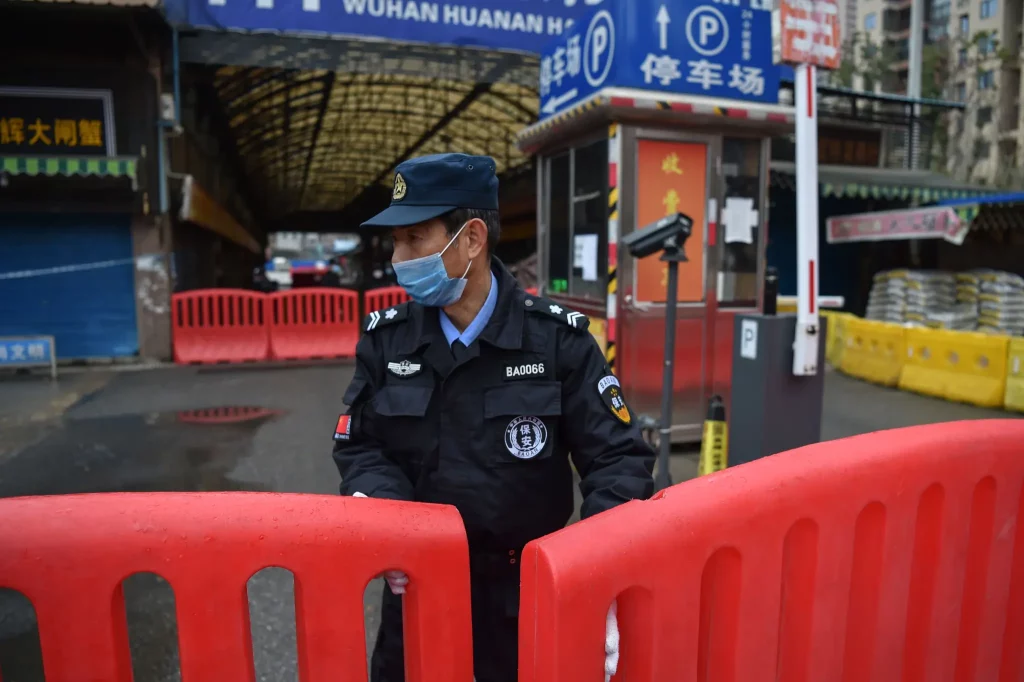Reevaluating the Lab Leak Theory and Media Snapback
Given that a significant portion of those who initially entertained the idea of the lab leak theory align with right-wing politics or support Trump, mainstream left-leaning media outlets tend to dismiss this theory. Instead of prioritizing journalistic integrity and curiosity, the decision to pursue a story seems to hinge on who presents it. Additionally, another significant factor contributing to this oversight is the initial subpar quality of the so-called “evidence” for a lab leak, which often resulted from mistranslations and substantial leaps in logic. This, in turn, has made people more hesitant to take subsequent claims seriously.

Image Credit: Thomas Peter/Reuters
In the whirlwind of the COVID-19 pandemic’s onset, a contentious and elusive question loomed large over public discourse: Where did this virus come from? Two primary theories quickly rose to prominence in the quest for the truth: the zoonotic spillover origin theory and the lab leak theory. The former posits that the virus naturally made the jump from an unknown animal host to humans, possibly through the Wuhan wet markets. The latter suggests that the virus escaped from the confines of the Wuhan Institute of Virology (WIV).
Early on, the lab leak theory generated a flood of unfounded speculations and conspiracy theories. This torrent of misinformation understandably raised eyebrows, causing mainstream media to adopt a more dismissive stance toward the theory. Some extreme versions of the theory painted a sinister picture of the Chinese government deliberately engineering the virus as a bioweapon, releasing it into the world intentionally. Others presented a more rational, scientifically grounded perspective, proposing an accidental lab escape as the cause, a far cry from the more malevolent conspiracy theories. Unfortunately, this dismissal failed to differentiate between the various forms of the lab leak theory, inadvertently grouping them together into a potentially dangerous oversimplification.
Publications like Vox, Politifact, and The Washington Post are not exempt from this blunder, as they frequently blurred the lines between the lab leak theory and its more extravagant, unfounded variations. This issue, in part, can be attributed to the tribal nature of contemporary news outlets. Given that a significant portion of those who initially entertained the idea of the lab leak theory align with right-wing politics or support Trump, mainstream left-leaning media outlets tend to dismiss this theory. Instead of prioritizing journalistic integrity and curiosity, the decision to pursue a story seems to hinge on who presents it. Additionally, another significant factor contributing to this oversight is the initial subpar quality of the so-called “evidence” for a lab leak, which often resulted from mistranslations and substantial leaps in logic. This, in turn, has made people more hesitant to take subsequent claims seriously.
Regrettably, this oversight had far-reaching consequences, causing the more reasonable aspects of the theory to be swept aside in the haste to denounce its more sensationalized versions. Politifact, in particular, had to retract one of their articles citing increased dispute over the assertion as their reason for doing so. Eventually, these concerns resurfaced with a renewed fervor when news broke about a US intelligence report, revealing that three researchers from the Wuhan Institute of Virology sought medical treatment for symptoms resembling COVID-19 in November 2019.
The implications of this unfortunate mishandling by the media are twofold and warrant our careful consideration. Firstly, the premature dismissal of legitimate concerns as mere conspiracy theories has a corrosive effect on public trust, both in journalism and in the very institutions that form the backbone of our society. When such concerns are hastily brushed aside, the public’s confidence in the rigor and discernment of the reporting process is eroded. People, justifiably concerned about the accuracy and responsibility of media outlets, have become increasingly hesitant to accept information from these sources.
Secondly, and perhaps more alarmingly, this mishandling provides ammunition for more extreme actors who exploit the situation to further undermine the credibility of institutions. It opens the floodgates for dissemination of unfounded claims and perilous misinformation, with tangible real-world repercussions. In our rapidly connected world, where information spreads at internet speeds, falsehoods and conspiracy theories can proliferate swiftly, sowing confusion, fear, and discord. When institutions are seen as untrustworthy or dishonest, they become susceptible to manipulation by those with ulterior motives. This phenomenon is especially treacherous during periods of high scientific uncertainty, such as the early stages of a global pandemic, when upholding institutional legitimacy among the public is of paramount importance.
While the initial dismissal was undoubtedly premature, the pendulum has now swung too far in the opposite direction. Recent media coverage has been marked by sensationalism, hyperbole, and a troubling lack of nuance. A particularly glaring example of this can be found in a Reason article titled “Lab Leak Theory: 1, Misinformation Cops: 0.” This article not only exhibits an unwarranted level of confidence regarding evidence supporting a lab leak origin of SARS-CoV-2 but also distorts the underlying facts that underpin the author’s argument. In this article, the author claims that there is solid evidence confirming that scientists at the WIV were among the first COVID-19 cases. This claim is used to support the idea that inadequate safety measures at the lab probably caused the virus to spread globally. Furthermore, the author argues that those advocating for a zoonotic origin of the virus are “running up against Occam’s razor.” This suggests that when there are multiple explanations, such as the zoonotic origin or lab leak theory, for a phenomenon like the COVID-19 pandemic, the simpler explanation—in this case, the lab leak theory—is often more probable. However, upon closer examination, it becomes apparent that this assertion lacks concrete supporting evidence.

The claim of the lab leak theory confirmation mentioned in Reason‘s article relies on information from a Wall Street Journal report, which unveiled new intelligence details. Reason builds its case for the lab leak theory on the basis that three researchers at the Wuhan Institute of Virology fell ill with respiratory symptoms in 2019, symptoms that resembled COVID-19. However, it’s essential to emphasize that the WSJ‘s report doesn’t definitively claim that these WIV scientists were infected with SARS-CoV-2. In fact, the report states: “The identity and role of the researchers is one piece of intelligence that has been cited by proponents of the judgment that the pandemic originated with a lab leak, though the nature of their illness hasn’t been conclusively established.”
In other words, although a few laboratory researchers experienced respiratory symptoms in 2019 consistent with COVID-19, determining the exact nature of their illness remained inconclusive, as these symptoms can overlap with those of other common illnesses such as colds or allergies. It’s also worth noting that the WIV did engage in research involving the genetic engineering of coronaviruses (which is a large family of viruses). But none of the coronaviruses documented in the WIV’s viral catalog had a genomic structure close enough in resemblance to have been the predecessor of SARS-CoV-2, the virus responsible for COVID-19. This important nuance is completely lost in the fervor of sensationalist reporting, leading to a troubling distortion of the degree of confidence in the evidence.
Distortions like these, akin to a game of “media telephone” without scruples, ultimately do a disservice to the pursuit of accurate and responsible journalism. They underscore the urgent need for media outlets to exercise caution, uphold the highest standards of fact-checking, and refrain from overhyping unverified claims. Moreover, they highlight the importance of adopting a nuanced and evidence-based approach when discussing complex issues like the origins of a global pandemic, regardless of one’s stance on the matter.
In the quest for the truth, we must strike a balance between skepticism and open-mindedness. The lab leak theory should have been taken seriously from the beginning, not as a wild conspiracy theory, but rather considered a plausible hypothesis worthy of investigation. The media’s swift dismissal, followed by an even more irresponsible snapback in the opposite direction, has only deepened societal divisions and eroded public trust. Looking ahead, it is imperative that we approach such intricate and delicate matters with nuance and discernment.
The truth may be elusive, but it is our duty as responsible citizens to engage in a fair and open examination of all possibilities. Only through such a balanced approach can we hope to rebuild the institutional trust that is so vital to our society’s well-being.
Phillip HoSang (he/him) is a writer and a 2nd-year Master’s student in NYU’s Media, Culture, and Communications Program. Born and raised in Brooklyn, New York, his research primarily focuses on the contemporary dynamics of mis/disinformation and the construction of different epistemic spaces. He regularly writes for a Medium publication he created titled Philling In The Gaps, where he works to improve information literacy, point out misinformation, explore broader cultural ideas, and promote healthier conversations around what it means to understand different topics.





